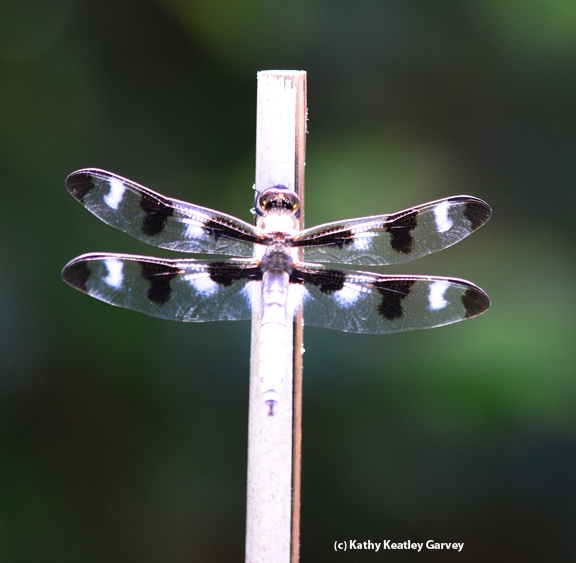
Last Sunday, however, a new species arrived--a male twelve-spotted skimmer (Libellula pulchella), as identified by naturalist Greg Kareofelas of Davis, an associate at the Bohart Museum of Entomology, UC Davis.
And a male, on Father's Day.
"The black spots on the wing tips, makes this a male Libellula pulchella," Kareofelas said.
The twelve-spotted skimmer flew in around noon, grabbed a few insects in flight (fast food!) and then perched on one of our bamboo stakes to eat them. Warily, he watched me approach. Fortunately, my 200mm macro lens allowed me to take a few shots before he took off.
This colorful little fellow is from the family, Libellulidae (skimmers); suborder Anisoptera (dragonflies); and order Odonata. By the way, if you're interested in buying the Bohart Museum poster, "Dragonflies of California," you can contact the museum at (530) 752-0493, or bmuseum@ucdavis.edu or visit the facility, located in Room 1124 of the Academic Surge Building on Crocker Lane. The museum, directed by Lynn Kimsey, UC Davis professor of entomology, is home of nearly eight million insect specimens. It is open to the public Mondays through Thursdays. The dragonfly poster is the work of then doctoral candidate Fran Keller (she now is "Dr. Fran") and Kareofelas.
According to BugguideGuide.net, Libellula pulchella "is found from British Columbia east to Nova Scotia, extending south through most of the U.S., from California east to Florida. It is absent from very dry areas. In Idaho, it occurs throughout most of the state except for the driest portions of the southwest."
Its habitat? Near lakes, ponds and marshes, particularly those with exposed shorelines.
Dragonflies like our yard due to the insects that fly over the fish pond and the insects that inhabit the pollinator garden, which offers quite a smorgasbord for predators. What does an adult dragonfly eat? Soft-bodied flying insects such as mosquitoes, flies, bees, butterflies, moths, mayflies, and the like. They are also very territorial and will chase away other dragonflies.
During the visit by the twelve-spotted dragonfly, two other dragonflies--red flameskimmers--appeared at the lunch counter.
It was a very good day for dragonflies.
Probably not so good for the sunflower bees and sweat bees...
Attached Images:

